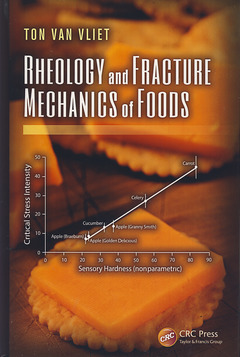Rheology and Fracture Mechanics of Foods
Auteur : Vliet Ton van

The mechanical properties of food play an important role during manufacturing, storage, handling, and last but not least, during consumption. For an adequate understanding of the mechanical properties of liquid, liquid-like, soft solid, and solid foods, a basic understanding of relevant aspects of rheology and fracture mechanics is essential. Focusing on basic principles, Rheology and Fracture Mechanics of Foods examines how rheological and fracture behavior in food relates to product structure.
Divided into three parts, the book reviews basic concepts and emphasizes aspects relevant for studying food products, raw materials, and intermediate products. It then introduces measuring methods and the equipment used for studying mechanical properties of food products, highlighting tests that deliver reproducible and interpretable data. The final part investigates the relation between rheological and fracture behavior of matter and physical structure at the relevant molecular, mesoscopic, and macroscopic length scales.
In addition to the basics of rheology and fracture mechanics, the book explores the relationship between measured mechanical properties and the structure of the different types of food and how they may determine texture perception. Containing practical examples of the relationship between food structure, mechanical properties, and sensory characteristics, this book provides an overview of these points for food science and food engineering students at the BSc / MSc level and people working in food research and development.
INTRODUCTION. Rheology and fracture mechanics in food science and technology. PHENOMENOLOGY. Basic Notions. Rheological quantities, types of deformation. Descriptive rheology. Yielding and fracture behavior. EXPERIMENTAL EVALUATION. Introduction. Measuring methods. Measuring apparatus. RELATION BETWEEN STRUCTURE and MECHANICAL PROPERTIES. General aspects. Dispersions. Dilute dispersions. Macromolecular solutions. Gels. Filled gels. Solids. Foam / Sponge structures. Wet cellular materials.
Date de parution : 09-2013
15.6x23.4 cm
Thèmes de Rheology and Fracture Mechanics of Foods :
Mots-clés :
Soy Proteins; Composite Food Products; Experimental Evaluation; Starch Granules; Relation Between Structure and Mechanical Properties; Critical Strain Energy Release Rate; Macromolecular solutions; Shear Rate Thinning; Rheological quantities; types of deformation; Potato Starch Gels; Foam; Sponge structures; Colloidal Interaction Forces; Shear Rate; Test Piece; Emulsion Droplets; non-Newtonian Liquids; Maxwell Element; Fracture Properties; Fracture Mechanics; Crack Growth; Fracture Stress; Intrinsic Viscosity; Fracture Behavior; Tomato Ketchup; Crack Tip; Apple Sauce; Plateau Border; Oral Processing; Gouda Cheese; Shear Thickening Fluid



